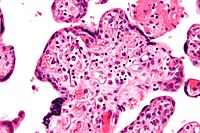
Photo from wikipedia
The intestinal microbiota is known to influence postnatal growth. We previously found that a strain of Lactiplantibacillus plantarum (strain LpWJL) buffers the adverse effects of chronic undernutrition on the growth… Click to show full abstract
The intestinal microbiota is known to influence postnatal growth. We previously found that a strain of Lactiplantibacillus plantarum (strain LpWJL) buffers the adverse effects of chronic undernutrition on the growth of juvenile germ-free mice. Here, we report that LpWJL sustains the postnatal growth of malnourished conventional animals and supports both insulin-like growth factor–1 (IGF-1) and insulin production and activity. We have identified cell walls isolated from LpWJL, as well as muramyl dipeptide and mifamurtide, as sufficient cues to stimulate animal growth despite undernutrition. Further, we found that NOD2 is necessary in intestinal epithelial cells for LpWJL-mediated IGF-1 production and for postnatal growth promotion in malnourished conventional animals. These findings indicate that, coupled with renutrition, bacteria cell walls or purified NOD2 ligands have the potential to alleviate stunting. Description Bacterial cell walls stimulate mice growth Malnutrition in infancy results in skeletal stunting and disrupts the establishment of the gut microbiota. Schwarzer et al. built on their earlier findings in the bacterium Lactiplantibacillus plantarum (LpWJL) in fruit flies to show that this strain of bacterium alone elevates circulating levels of insulin growth factor–1 (IGF-1) in malnourished mice (see the Perspective by Yadav and Philpot). LpWJL did not need to be alive to have this effect, because a cell wall extract was sufficient to increase femur length and stimulate IGF-1. This effect was mediated through an innate immune receptor in the gut called NOD2, which recognizes bacterial muramyl dipeptide structures. The authors suggest that LpWJL stimulates malnutrition-suppressed NOD2 signaling in the crypt. Increased NOD2 signaling increases intestinal cell proliferation and improves nutrient absorption, which then stimulates activity of the nutrient-sensitive growth hormone/IGF-1/insulin axis, prompting postnatal growth. —CA Cell wall material from a specific bacterial strain is sufficient to stimulate innate immune signaling for skeletal growth during malnutrition. INTRODUCTION Growth in size and weight is an intrinsic process in each individual’s ontogeny. The highest rate of growth takes place after birth and in mammals is governed by the somatotropic axis, where growth hormone (GH) instructs the liver and peripheral tissues to produce insulin-like growth factor–1 (IGF-1) to promote organ and systemic growth. Nutrition is paramount to growth, and chronic undernutrition triggers a state of GH resistance manifested by low circulating IGF-1, leading to stunting. Recent studies have shown that not only nutrients but also components of the intestinal microbiota can be critical in shaping host growth dynamics. Previously, we established that the intestinal microbiota is necessary to buffer the deleterious effect of chronic undernutrition on mouse systemic postnatal growth. We showed that microbial stimulation supports the activity of the somatotropic axis in juveniles by improving the GH sensitivity of peripheral tissues and increasing the circulating levels of IGF-1. Furthermore, using monoxenic mice, we showed that a strain of Lactiplantibacillus plantarum (strain LpWJL), which was selected because of its ability to promote growth in a Drosophila model of diet-induced stunting, recapitulates the beneficial effects of a complex microbiota on the somatotropic axis and juvenile growth of malnourished mice in a strictly strain-dependent manner. RATIONALE Here, we studied the effect LpWJL on mouse postnatal growth in a new preclinical model of diet-induced stunting in conventional animals. We investigated both the bacterial cues and host mechanisms underpinning the complex local and whole-body adaptations triggered by such intestinal bacterium leading to improved systemic growth despite chronic undernutrition. RESULTS We report a new preclinical mouse model of diet-induced stunting in conventional mice without small intestinal inflammation but associated with altered crypt cell proliferation. Using this model, we show that LpWJL sustains the postnatal growth of malnourished conventional animals by orchestrating metabolic and hormonal changes in the juvenile host manifested as improved circulating levels and activity of IGF-1 and insulin. We identified cell walls isolated from LpWJL, as well as ligands of the pattern recognition receptor NOD2, as being sufficient bacterial cues stimulating animal growth. Further, we found that NOD2 is necessary in intestinal epithelial cells for LpWJL-mediated improvement of intestinal crypt cell proliferation, type I interferon–regulated gene induction, IGF-1 production, and postnatal growth promotion in malnourished conventional animals. CONCLUSION Our results demonstrate that bacterial cell walls or purified NOD2 ligands are sensed by the pattern recognition receptor NOD2 in the intestinal epithelial cells and sustain postnatal juvenile growth despite chronic undernutrition. We posit that one of the mechanisms by which LpWJL and its cell wall exert its postnatal growth–promoting properties is the buffering of the deleterious effect of undernutrition on small intestinal crypt cell proliferation through NOD2-dependent bacterial cell walls sensing. Our results suggest that, coupled with renutrition strategies, supplementation of evidence-based probiotics such as LpWJL or defined bacteria-derived postbiotics such as LpWJL cell walls and/or NOD2 agonists have the potential to alleviate persistent stunting, one of the long-term sequelae of undernutrition that still affects >149 million children under 5 years of age in low- and middle-income countries. LpWJL or its purified cell wall improves the growth of undernourished infant mice through intestinal NOD2 signaling. Chronic undernutrition after weaning leads to stunting, which is alleviated by LpWJL. LpWJL peptidoglycans engage NOD2 in the intestinal epithelium, which increases the proliferation of small intestinal stem cells, type I interferon signaling, IGF-1 production, and postnatal growth despite undernutrition.
Journal Title: Science
Year Published: 2023
Link to full text (if available)
Share on Social Media: Sign Up to like & get
recommendations!